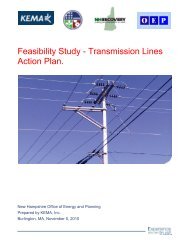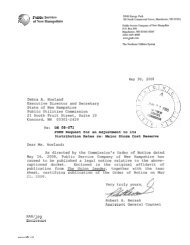Jurisdictional Propane Systems - New Hampshire Public Utilities ...
Jurisdictional Propane Systems - New Hampshire Public Utilities ...
Jurisdictional Propane Systems - New Hampshire Public Utilities ...
You also want an ePaper? Increase the reach of your titles
YUMPU automatically turns print PDFs into web optimized ePapers that Google loves.
Mike Israni<br />
Stan Kastanas<br />
Jim Osterhaus<br />
Mike Falk<br />
David Burnell<br />
Roger Huston<br />
PHMSA Senior Technical<br />
Advisor<br />
PHMSA<br />
Texas RR Commission<br />
PHMSA Central Region<br />
NAPSR NH PUC<br />
CYCLA
NFPA 58 “Liquefied Petroleum Gas Code”<br />
Governs the use of LPG, including non-pipeline uses<br />
NFPA 59 “Utility LP-Gas Plant Code”<br />
Governs utility gas plants using LPG for peak<br />
shaving<br />
Both are adopted by PHMSA pipeline safety regulations<br />
192.11 requires LPG plants/ pipeline<br />
systems to follow both 192 and relevant standard
The latest versions were not adopted in 2010<br />
regulation update rule; 2004 versions retained<br />
July 22, 2009, proposed rule provided reasons:<br />
NFPA 58-2008 has lesser requirements for odorization;<br />
distribution valve maintenance; operation and<br />
maintenance, emergency, and public awareness<br />
planning<br />
NFPA 58-2008 not applicable retroactively (Chapter 14)<br />
NFPA 59-2008 not consistent with scope of pipeline<br />
facilities subject to regulation (192.1(b)(5)) and<br />
corrosion control requirements (10 or more)
192.11(c) specifies that NFPA 58 and 59 prevail in<br />
event of conflict with 192<br />
This would result in “lesser” requirements<br />
taking precedence over 192<br />
Primacy of standards is unusual;<br />
regulations usually prevail<br />
PHMSA has proposed revising 192.11(c) to<br />
provide that requirements of 192 should prevail
PHMSA withdrew proposed change to<br />
192.11(c) – primacy<br />
Working with NFPA, AGA and NPGA to<br />
identify and address “lesser”<br />
requirements in the standards<br />
PHMSA is considering options for dealing<br />
with primacy issue
Part 192 NFPA 58 NFPA 59<br />
Subpart A - General<br />
§ 192.5 Class locations.<br />
(a) This section classifies<br />
pipeline locations for<br />
purposes of this part. The<br />
following criteria apply to<br />
classifications under this<br />
section.<br />
(Details omitted)<br />
No corresponding requirement<br />
No corresponding<br />
requirement
192 has retroactive subparts A General, I Corrosion Requirements, K Uprating,<br />
L Operations, M Maintenance, O Transmission Integrity, P Gas Distribution<br />
Integrity. NFPA 58 is not retroactive unless stated, NFPA 59 in the 2012 edition<br />
added 1.3.4<br />
Part 192 NFPA 58 NFPA 59<br />
§ 192.13 What general requirements apply<br />
to pipelines regulated under this part?<br />
(a) No person may operate a segment of<br />
pipeline listed in the first column that is<br />
readied for service after the date in the<br />
second column, unless:<br />
(1) The pipeline has been designed,<br />
installed, constructed, initially inspected,<br />
and initially tested in accordance with this<br />
part; or<br />
(2) The pipeline qualifies for use under this<br />
part according to the requirements in<br />
§192.14.<br />
(b) No person may operate a segment of<br />
pipeline listed in the first column that is<br />
replaced, relocated, or otherwise changed<br />
after the date in the second column, unless<br />
the replacement, relocation or change has<br />
been made according to the requirements in<br />
this part.<br />
1.4.2 Unless otherwise specified, the<br />
provisions of this code shall not apply to<br />
facilities, equipment, appliances, structures,<br />
or installations that existed or were approved<br />
for construction or installation prior to the<br />
effective date of the code. Equipment and<br />
appliances include stocks in manufacturers’<br />
storage, distribution warehouses, and<br />
dealers’ storage and showrooms in<br />
compliance with the provisions of this code<br />
in effect at the time of manufacture. Where<br />
specified, the provisions of this code shall be<br />
retroactive.<br />
1.3 Retroactivity.<br />
1.3.1 Unless otherwise specified, the<br />
provisions of this code shall not apply to<br />
facilities, equipment, structures, or<br />
installations that existed or were approved<br />
for construction or installation prior to the<br />
effective date of the code. Where<br />
specified, the provisions of this code shall<br />
be retroactive.<br />
1.3.2 In those cases where the authority<br />
having jurisdiction determines that the<br />
existing situation presents an<br />
unacceptable degree of risk, the authority<br />
having jurisdiction shall be permitted to<br />
apply retroactively any portions of this<br />
code deemed appropriate.<br />
1.3.4 The provision of Chapter 11,<br />
Operations, and Chapter 12, Maintenance,<br />
shall be applied to all facilities<br />
retroactively.
192 & NFPA 58 are similar with pipe standards where as NFPA 59 just<br />
says steel<br />
Part 192 NFPA 58 NFPA 59<br />
§ 192.55 Steel pipe.<br />
(a) <strong>New</strong> steel pipe is qualified for<br />
use under this part if:<br />
(1) It was manufactured in<br />
accordance with a listed<br />
specification;<br />
(2) It meets the requirements of—<br />
(i) Section II of appendix B to this<br />
part; or<br />
(ii) If it was manufactured before<br />
November 12, 1970, either<br />
section II or III of appendix B to<br />
this part; or<br />
(3) It is used in accordance with<br />
paragraph (c) or (d) of this<br />
section.<br />
5.9.3.1 Pipe shall be wrought iron or steel<br />
(black or galvanized), brass, copper,<br />
polyamide, or polyethylene and shall<br />
comply with the following:<br />
(1) Wrought iron: ASME B36.10M,<br />
Welded and Seamless Wrought Steel<br />
Pipe<br />
(2) Steel pipe: ASTM A 53, Standard<br />
Specification for Pipe, Steel, Black and<br />
Hot-Dipped, Zinc-Coated Welded and<br />
Seamless<br />
(3) Steel pipe: ASTM A 106, Standard<br />
Specification for Seamless Carbon Steel<br />
Pipe for High-Temperature Service<br />
(4) Brass pipe: ASTM B 43, Standard<br />
Specification for Seamless Red Brass<br />
Pipe, Standard Sizes<br />
(5) Copper pipe:ASTM B 42, Standard<br />
Specification for Seamless Copper Pipe,<br />
Standard Sizes<br />
7.1.1.3 Pressure-containing metal<br />
parts of equipment for application<br />
temperatures of –20°F (–29°C) or<br />
above shall be fabricated of one of<br />
the following materials:<br />
(1) Steel<br />
(2) Ductile (nodular) iron in<br />
accordance with ASTM A 395,<br />
Specification for Ferritic Ductile<br />
Iron Pressure-Retaining Castings<br />
for Use at Elevated Temperatures,<br />
or malleable iron in accordance<br />
with ASTM A 536, Specifications<br />
for Ductile Iron Castings, Grade<br />
60-40-18 or 65-45-12<br />
(3) Malleable iron in accordance<br />
with ASTM A 47, Standard<br />
Specification for Ferritic Malleable<br />
Iron Castings; brass; bronze; or<br />
equivalent copper alloys
192 limits copper to 100 psi In NFPA 58 this would be a problem<br />
because copper is used at over 100 psi to connect tanks and NFPA 59<br />
does not allow copper<br />
Part 192 NFPA 58 NFPA 59<br />
§ 192.125 Design of copper pipe.<br />
(a) Copper pipe used in mains must<br />
have a minimum wall thickness of<br />
0.065 inches (1.65 millimeters) and<br />
must be hard drawn.<br />
(b) Copper pipe used in service lines<br />
must have wall thickness not less than<br />
that indicated in the following table:<br />
(Table omitted)<br />
(c) Copper pipe used in mains and<br />
service lines may not be used at<br />
pressures in excess of 100 p.s.i. (689<br />
kPa) gage.<br />
5.9.3 Pipe and Tubing.<br />
5.9.3.1 Pipe shall be wrought iron or steel<br />
(black or galvanized), brass, copper,<br />
polyamide, or polyethylene and shall<br />
comply with the following:<br />
* * *<br />
(5) Copper pipe: ASTM B 42, Standard<br />
Specification for Seamless Copper Pipe,<br />
Standard Sizes (<strong>New</strong>/revised in 2008)<br />
* * *<br />
5.9.3.2 Tubing shall be steel, stainless<br />
steel, brass, copper, polyamide, or<br />
polyethylene (see 6.9.4) and shall comply<br />
with the following:<br />
* * *<br />
(32) Copper tubing:<br />
(a) Type K or L: ASTM B 88, Standard<br />
Copper pipe not allowed.
192 allows the use of cast iron pipe, NFPA 58 & NFPA 59 both do not<br />
allow cast iron pipe<br />
Part 192 NFPA 58 NFPA 59<br />
§ 192.275 Cast iron pipe.<br />
(a) Each caulked bell and spigot<br />
joint in cast iron pipe must be<br />
sealed with mechanical leak<br />
clamps.<br />
(b) Each mechanical joint in cast<br />
iron pipe must have a gasket<br />
made of a resilient material as the<br />
sealing medium. Each gasket<br />
must be suitably confined and<br />
retained under compression by a<br />
separate gland or follower ring.<br />
(c) Cast iron pipe may not be<br />
joined by threaded joints.<br />
(d) Cast iron pipe may not be<br />
joined by brazing<br />
Cast iron pipe is not allowed<br />
Cast iron pipe is not allowed
192, NFPA 58 & 59 all have similar requirements for odorization levels<br />
but 192 requires testing with an instrument to determine the<br />
percentage of gas in air.<br />
Part 192 NFPA 58 NFPA 59<br />
§ 192.625 Odorization of gas.<br />
(a) A combustible gas in a distribution<br />
line must contain a natural odorant<br />
or be odorized so that at a<br />
concentration in air of one-fifth of<br />
the lower explosive limit, the gas is<br />
readily detectable by a person with<br />
a normal sense of smell.<br />
(f) To assure the proper concentration<br />
of odorant in accordance with this<br />
section, each operator must conduct<br />
periodic sampling of combustible<br />
gases using an instrument capable of<br />
determining the percentage of gas in<br />
air at which the odor becomes readily<br />
detectable.<br />
4.2 LP-Gas Odorization.<br />
4.2.1* All LP-Gases shall be odorized<br />
prior to delivery to a bulk plant by the<br />
addition of a warning agent of such<br />
character that the gases are detectable,<br />
by a distinct odor, to a concentration in air<br />
of not over one-fifth the lower limit of<br />
flammability.<br />
4.2* Odorizing Gases. All LP-<br />
Gases shall be odorized by the<br />
addition of a warning agent of<br />
such character that they are<br />
detectable by a distinct odor down<br />
to a concentration in air of not over<br />
one-fifth the lower limit of<br />
flammability.
192 requires periodic leakage surveys on distribution systems. NFPA<br />
58 & 59 do not have this survey requirement. NFPA 59 does not cover<br />
distribution systems so this requirement would only apply to NFPA 58<br />
Part 192 NFPA 58 NFPA 59<br />
§ 192.723 Distribution systems:<br />
Leakage surveys.<br />
(a) Each operator of a distribution<br />
system shall conduct periodic<br />
leakage surveys in accordance<br />
with this section.<br />
(b) The type and scope of the<br />
leakage control program must be<br />
determined by the nature of the<br />
operations and the local<br />
conditions, but it must meet the<br />
following minimum requirements:<br />
No corresponding requirement<br />
No corresponding requirement
PHMSA in the spring of 2012 will put out a Notice of<br />
Proposed Rule Making to adopt more current standards of<br />
NFPA 58 & 59<br />
PHMSA plans to propose a new subpart that would<br />
address Requirements Applicable to Pipelines<br />
Transporting Petroleum Gas<br />
1. Applicability of standards for different types of systems<br />
identify which systems are covered by a standard<br />
2. Identify unique scope for standards and 192 – avoid<br />
conflict by avoiding dual requirements

















